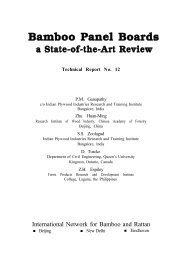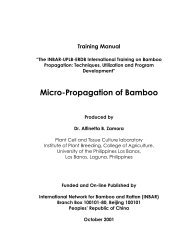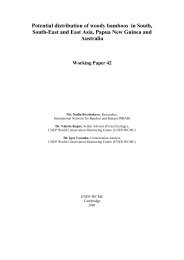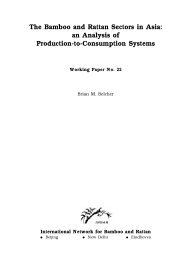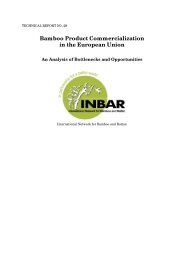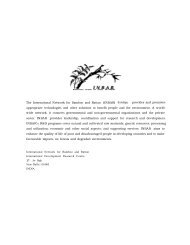ISSN ………… - International Network for Bamboo and Rattan
ISSN ………… - International Network for Bamboo and Rattan
ISSN ………… - International Network for Bamboo and Rattan
Create successful ePaper yourself
Turn your PDF publications into a flip-book with our unique Google optimized e-Paper software.
termed ‘xylans’ or more loosely ‘pentosans’. Those contain mannose units linked to each other <strong>and</strong> to<br />
glucose units have been referred as ‘mannans’.<br />
The hemicelluloses (when freed from lignin) swell more than does cellulose <strong>and</strong> are in part dispersible in<br />
water. They have adhesive properties not shared by cellulose. Whereas cellulose is fibrous,<br />
hemicelluloses are non-fibrous. Whereas cellulose is quite insoluble in cold alkali, hemicelluloses are<br />
quite soluble in dilute caustic soda. In any chemical pulping operations, some of the initial hemicelluloses<br />
are retained in the pulp. A portion of the less resistant hemicelluloses is removed during digestion, <strong>and</strong><br />
their degradation products are then found in the spent liquors.<br />
In the case of pulps freed from lignin by adequate <strong>and</strong> controlled bleaching, the hemicelluloses have been<br />
shown repeatedly to contribute greatly to tensile <strong>and</strong> bursting strength <strong>and</strong> to folding endurance of the<br />
pulp sheet. Both the quantity <strong>and</strong> the type of hemicelluloses in a pulp influence the pulp properties <strong>and</strong><br />
the type of paper that can be made from such a pulp. There are certain disadvantages also about their<br />
presence. These are undesirable <strong>for</strong> dissolving grade pulp. In the case of certain bleached pulps, these are<br />
responsible <strong>for</strong> a loss in brightness of the bleached pulp on storage or aging.<br />
3.1.3. Lignin<br />
Lignin is the cementing substance between fibres <strong>and</strong> tissues <strong>and</strong> is concentrated mainly in the region of<br />
the middle lamella <strong>and</strong> imparts rigidity to wood tissue. Lignin exists in wood or bamboo as branchedchain<br />
polymer molecules. The lignin may be separated from an associated wood component either by<br />
preferentially dissolving lignin or by preferentially dissolving non-lignin components. Isolated lignins, in<br />
general, are amorphous <strong>and</strong> non-crystalline, <strong>and</strong> show definite softening points at elevated temperatures.<br />
The average molecular weight is in the range of 11,000. An important property of lignin is its capacity to<br />
absorb ultra violet light. The chemical skeleton of lignin is a phenylpropane or a “C6 – C3” or a “C9” type.<br />
Pulping is basically <strong>and</strong> mainly a delignification process employing inorganic acids or alkalies <strong>and</strong> other<br />
compounds or organic solvents <strong>and</strong> compounds or by employing biological agents such as certain fungi<br />
which will selectively attack on lignin, causing its degradation <strong>and</strong> consequent dissolution. The amount<br />
<strong>and</strong> reactivity of lignin have a marked effect on the pulpability of the material. These differ depending<br />
upon the raw material (softwoods, hardwoods, bamboos, etc.). During most pulping reactions,<br />
components other than lignin are simultaneously removed. The character of pulp depends upon the <strong>for</strong>m<br />
<strong>and</strong> amount of energy supplied <strong>for</strong> accomplishing the separation. Chemical, mechanical or a combination<br />
of the two <strong>for</strong>ms of energy are utilized. In general, when chemical energy alone is supplied, completely<br />
separated fibres are obtained; whereas in mechanical <strong>and</strong> semichemical pulping (combination of<br />
5



